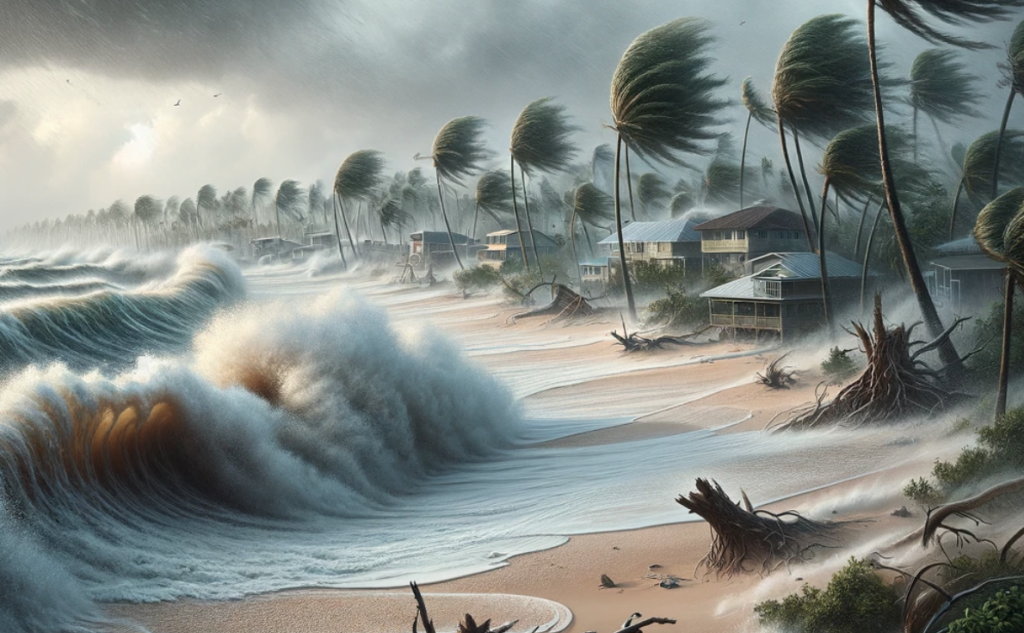Introduction: Hurricanes, with their powerful winds and torrential rains, are among the most formidable weather events on Earth. In this educational post, we’ll embark on a journey to unravel the mysteries of hurricanes, exploring their unique characteristics, formation processes, impacts, and crucial safety measures.
Characteristics of Hurricanes: Hurricanes are known for several defining features that set them apart from other storms:
- Strong Winds: Hurricanes have strong winds that, on a larger scale, move counterclockwise in the Northern Hemisphere and clockwise in the Southern Hemisphere. On the smaller scale, as you stand outside in the storm, the wind are straight-line.
- Eye of the Storm: At the center of a hurricane is the “eye,” a calm and clear area surrounded by the most intense winds and heavy rain.
- Heavy Rainfall: Hurricanes bring copious amounts of rain, often leading to flooding and water-related hazards.
- Storm Surge: The combination of strong winds and low pressure in a hurricane can result in a storm surge, causing coastal flooding.

Formation of Hurricanes: Hurricanes form through a specific process that requires warm ocean waters and favorable atmospheric conditions:
- Warm Ocean Waters:
- The first key ingredient for hurricane formation is warm ocean waters, typically with sea surface temperatures of at least 26 degrees Celsius (79 degrees Fahrenheit) or higher. Warm waters serve as the primary source of energy for hurricanes.
- Sunlight warms the ocean’s surface, causing evaporation of water into the atmosphere. This process releases latent heat, which is stored energy within water vapor.
- Low-Pressure System Formation:
- Atmospheric disturbances play a crucial role in hurricane formation. These disturbances can originate from various sources, including the intertropical convergence zone (ITCZ), frontal boundaries, or tropical waves.
- When an area of low pressure forms in the atmosphere, it creates a region where air rises. As air rises, it cools and condenses, forming clouds and releasing more latent heat, further lowering air pressure.
- Development of a Tropical Disturbance:
- If the low-pressure system persists and conditions are favorable, a tropical disturbance may develop. A tropical disturbance is characterized by disorganized thunderstorms and a loosely defined circulation pattern.
- As warm, moist air from the ocean is drawn into the disturbance, it adds moisture and heat to the system, fueling its growth.
- Rotation and Organization:
- As the tropical disturbance continues to evolve, the Coriolis effect, a result of the Earth’s rotation, begins to influence the system. The Coriolis effect causes the developing disturbance to spin and take on a counterclockwise rotation in the Northern Hemisphere and a clockwise rotation in the Southern Hemisphere.
- This rotation leads to the development of a tropical depression. In this stage, the system becomes more organized, with a closed circulation center and sustained winds of up to 38 miles per hour (61 kilometers per hour).
- Intensification into a Hurricane:
- If the tropical depression encounters even warmer ocean waters and low vertical wind shear (the change in wind speed and direction with altitude), it can continue to intensify.
- As the system gains strength, it progresses through the stages of a tropical storm (with sustained winds of 39 to 73 mph or 63 to 118 km/h) and eventually reaches hurricane status (with sustained winds of 74 mph or 119 km/h or higher).
- Hurricanes are categorized based on their wind speed using the Saffir-Simpson Hurricane Wind Scale, which ranges from Category 1 (weakest) to Category 5 (strongest).
Impacts of Hurricanes: Hurricanes can have devastating impacts on coastal areas and beyond:
- Strong Winds: Hurricane-force winds can cause extensive damage to structures, trees, and power lines.
- Heavy Rainfall: Intense rainfall can lead to flash floods, river flooding, and landslides.
- Storm Surge: The storm surge can inundate coastal areas, causing widespread flooding and property damage.
- Tornadoes: Hurricanes often spawn tornadoes, adding to the destructive potential of the storm.
Safety Measures During Hurricanes: Staying safe during a hurricane requires careful planning and adherence to safety measures:
- Evacuation: If authorities issue evacuation orders, follow them promptly and know your evacuation routes.
- Shelter: Seek shelter in a sturdy building, away from windows and doors, if you cannot evacuate.
- Emergency Kit: Prepare an emergency kit with essentials, including water, non-perishable food, flashlights, batteries, and important documents.
- Stay Informed: Monitor hurricane forecasts and warnings from trusted sources, such as the National Hurricane Center (NHC) or local authorities.
- Secure Property: Secure loose outdoor items, board up windows, and reinforce your home if possible.
Take Home: Hurricanes are awe-inspiring yet perilous meteorological phenomena that underscore the power of nature. Understanding their characteristics, formation, impacts, and safety measures is essential for coastal residents and anyone living in hurricane-prone regions.
We hope this exploration of hurricanes has provided valuable insights and emphasized the importance of preparedness and vigilance when facing these formidable storms. If you have further questions or topics you’d like us to explore, please feel free to reach out. Stay safe and stay informed when hurricanes threaten your region!

